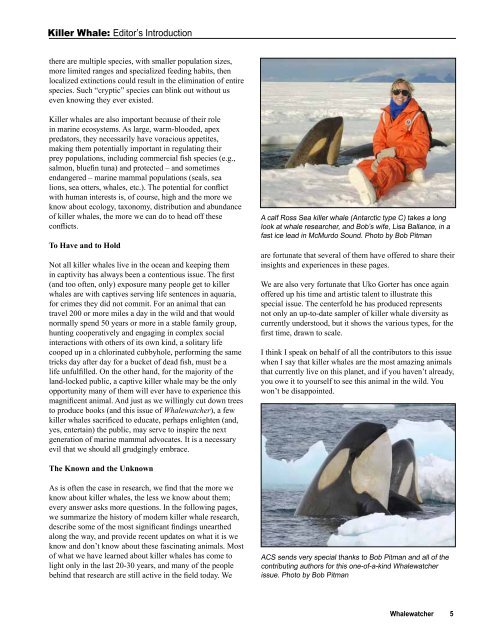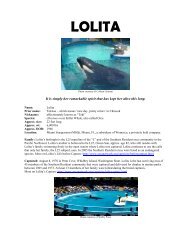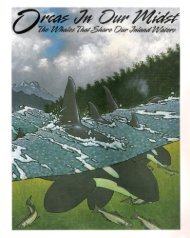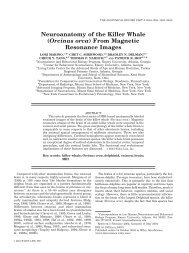Killer Whale: - Orca Network
Killer Whale: - Orca Network
Killer Whale: - Orca Network
Create successful ePaper yourself
Turn your PDF publications into a flip-book with our unique Google optimized e-Paper software.
<strong>Killer</strong> <strong>Whale</strong>: Editor’s Introduction<br />
there are multiple species, with smaller population sizes,<br />
more limited ranges and specialized feeding habits, then<br />
localized extinctions could result in the elimination of entire<br />
species. Such “cryptic” species can blink out without us<br />
even knowing they ever existed.<br />
<strong>Killer</strong> whales are also important because of their role<br />
in marine ecosystems. As large, warm-blooded, apex<br />
predators, they necessarily have voracious appetites,<br />
making them potentially important in regulating their<br />
prey populations, including commercial fish species (e.g.,<br />
salmon, bluefin tuna) and protected – and sometimes<br />
endangered – marine mammal populations (seals, sea<br />
lions, sea otters, whales, etc.). The potential for conflict<br />
with human interests is, of course, high and the more we<br />
know about ecology, taxonomy, distribution and abundance<br />
of killer whales, the more we can do to head off these<br />
conflicts.<br />
To Have and to Hold<br />
Not all killer whales live in the ocean and keeping them<br />
in captivity has always been a contentious issue. The first<br />
(and too often, only) exposure many people get to killer<br />
whales are with captives serving life sentences in aquaria,<br />
for crimes they did not commit. For an animal that can<br />
travel 200 or more miles a day in the wild and that would<br />
normally spend 50 years or more in a stable family group,<br />
hunting cooperatively and engaging in complex social<br />
interactions with others of its own kind, a solitary life<br />
cooped up in a chlorinated cubbyhole, performing the same<br />
tricks day after day for a bucket of dead fish, must be a<br />
life unfulfilled. On the other hand, for the majority of the<br />
land-locked public, a captive killer whale may be the only<br />
opportunity many of them will ever have to experience this<br />
magnificent animal. And just as we willingly cut down trees<br />
to produce books (and this issue of <strong>Whale</strong>watcher), a few<br />
killer whales sacrificed to educate, perhaps enlighten (and,<br />
yes, entertain) the public, may serve to inspire the next<br />
generation of marine mammal advocates. It is a necessary<br />
evil that we should all grudgingly embrace.<br />
A calf Ross Sea killer whale (Antarctic type C) takes a long<br />
look at whale researcher, and Bob’s wife, Lisa Ballance, in a<br />
fast ice lead in McMurdo Sound. Photo by Bob Pitman<br />
are fortunate that several of them have offered to share their<br />
insights and experiences in these pages.<br />
We are also very fortunate that Uko Gorter has once again<br />
offered up his time and artistic talent to illustrate this<br />
special issue. The centerfold he has produced represents<br />
not only an up-to-date sampler of killer whale diversity as<br />
currently understood, but it shows the various types, for the<br />
first time, drawn to scale.<br />
I think I speak on behalf of all the contributors to this issue<br />
when I say that killer whales are the most amazing animals<br />
that currently live on this planet, and if you haven’t already,<br />
you owe it to yourself to see this animal in the wild. You<br />
won’t be disappointed.<br />
The Known and the Unknown<br />
As is often the case in research, we find that the more we<br />
know about killer whales, the less we know about them;<br />
every answer asks more questions. In the following pages,<br />
we summarize the history of modern killer whale research,<br />
describe some of the most significant findings unearthed<br />
along the way, and provide recent updates on what it is we<br />
know and don’t know about these fascinating animals. Most<br />
of what we have learned about killer whales has come to<br />
light only in the last 20-30 years, and many of the people<br />
behind that research are still active in the field today. We<br />
ACS sends very special thanks to Bob Pitman and all of the<br />
contributing authors for this one-of-a-kind <strong>Whale</strong>watcher<br />
issue. Photo by Bob Pitman<br />
<strong>Whale</strong>watcher 5







